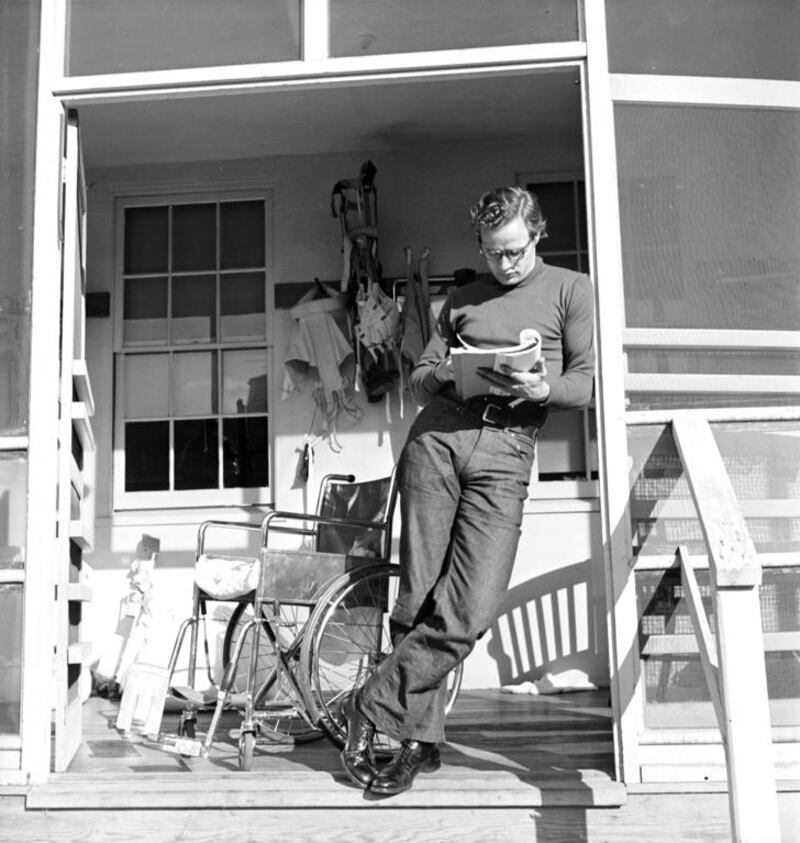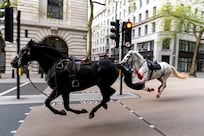There’s something deliberately ironic about the title of Susan L Mizruchi’s new biography of one of Hollywood’s iconic actors, Marlon Brando. “When you think of Brando,” Mizruchi writes, “you don’t think of a smile. Granted, comedy was not his forte and most of the characters he played were unaccustomed to happiness. But equally important was his understanding of smiles as indices of vulnerability or manipulation.”
Brando himself had commented early in his career, while making his fourth film, an adaptation of Shakespeare's Julius Caesar, that, although he was now being "paid around $125,000 and more" per picture, he never expected to "get the kind of big fat grins that go with $250,000 a picture. They only pay that kind of money to cowboy stars." The most that Brando could expect at that point in his career, were the ones that showed teeth "locked together. The smile goes up at the corners, but the teeth are set."
Mizruchi uses this anecdote to set up the argument of her book Brando's Smile [Amazon.com; Amazon.co.uk], which portrays Brando as a craftsman who had a love-hate relationship with acting and with the celebrity that accompanied his pursuit of it. This portrayal flies in the face of the widely held perception that Brando was an actor who succeeded because of sex appeal and little else. Consider the title of Darwin Porter's 2006 biography: Brando Unzipped: Marlon Brando: Bad Boy, Megastar, Sexual Outlaw. Mizruchi's account couldn't be more different from Porter's tabloid treatment. What interests her about Brando's smile is not the role it played in his personal life but rather the role that it played in his films. "When he does smile in films," she notes, "it's usually compromised in some way – it's a half-smile, or an ironic smile, or a smile threatening to collapse into something sad or sinister."
It’s the irony behind Brando’s life and work that Mizruchi seeks to recover: her goal is to explore “the Brando that was not visible to the world in order to better understand the one that was”. Crucial to her presentation is the unexpected word that appears in her subtitle: “thought”. If previous commentators on his life and work haven’t thought to include the idea of “thought” when discussing him, it’s perhaps because they have fallen prey to Brando’s own ironic self-presentation. Mizruchi tells us that visitors to Brando’s home “regularly remarked on the few signs of his profession”, unaware that “in a shed on his estate there were piles of carefully preserved scripts, notes, papers and memorabilia from each of his films – every one a time capsule with preparations for the specific movie and evidence of the ordinary life that continued while making it”.
Brando’s estate also housed “a book collection that outstripped those of most academics”: although he was a poor student because of his resistance to the regimentation imposed by the schools and the military academy he attended as a boy and teenager, Brando was a lifelong reader and annotator of books. At his death in 2004, his library contained more than 4,000 volumes, some of which he had owned since his teenage years. According to Mizruchi: “Brando began collecting books in earnest as a young actor in Manhattan and added to the library throughout his life.” Where other chroniclers of Brando’s life have focused on his legendary appetite for women and for food, Mizruchi instead focuses on his appetite for books and knowledge, which seems to have been equally prodigious.
What sets Brando's Smile apart from other biographies of the actor is the fact that Mizruchi is the first biographer to have had access to Brando's archives, including both his books and his personal papers. Mizruchi, a scholar of American literature who is a professor of English at Boston University, brings considerable research skills to bear on her subject: the biography is heavily annotated and draws on Brando's archives as well as on extensive interviews with his family and friends.
A great deal of Brando’s personal archive material – which included books, film scripts, research materials and notes for films – was sold at auction in 2005 by Christie’s but the auction house passed on Mizruchi’s requests for access to the material to its clients. The Brando Estate also granted Mizruchi access to its archives, enabling her to create a portrait of the actor as a craftsman and intellectual.
It's telling, for example, that Brando befriended James Baldwin when the writer was still unpublished and kept up a lifelong friendship. Mizruchi writes that "almost upon meeting", Brando and Baldwin "began a process of mutual education", with Baldwin proving to be "pivotal to Brando's enlightenment" about ongoing injustice in the United States and around the world. It's equally telling that Brando saved only one review of his controversial 1972 film Last Tango in Paris, a review that "discussed the connection between the film and [Albert] Camus's novel" The Fall (1957), which Brando owned and "annotated heavily".
Details like these bring Brando’s “thought” to vivid life. Mizruchi makes frequent reference to Brando’s marginalia throughout her book, because she believes that Brando’s reading shaped his intellect, which in turn shaped the performances that he crafted on stage and screen, as well as his off-screen commitment to political activism and such causes as Native American rights. Indeed, Mizruchi presents this intellectual context first, before going back to trace the ways in which his family history and his studies in New York with the great acting teacher Stella Adler also helped to shape Brando as an actor.
A child of the Midwest, whose forebears were immigrants from England, Ireland and Germany, Brando was also the child of alcoholics. Mizruchi argues that “though alcoholism ran in the family, so did the faith that human weaknesses could be corrected”. The Brando that emerges from her account is a nonconformist who seems to embrace American mythologies of individualism and self-making in his personal life, but who also seems to use his acting to get his audiences to think critically about those very mythologies.
The ironic smile with which Mizruchi begins her account is one tool that Brando uses to invite this critical stance. Brando commented in his autobiography about the crucial role that the audience plays in creating the meaning of a given performance. Noting that “storytelling is a basic part of every human culture”, Brando cautioned that an actor “should never forget that it is the audience that really does the work … every theatrical event, from those taking place in Stone Age caves to Punch-and-Judy shows and Broadway plays, can produce an emotional participation from the audience, who become the actors in the drama”.
For this reason, Brando would tell people that he preferred the performances that he gave in Burn! (1969), in which he played a professional mercenary who incites a Caribbean slave revolt to boost the British sugar trade, or in Last Tango in Paris to his iconic performance as Terry Malloy, the boxer who laments "I coulda been a contender" in On the Waterfront (1954), generally regarded as one of the great performances in American screen history. Mizruchi puts it this way: "Terry Malloy was an everyman whose regret for what might have been was deeply affecting, while the plot and characters of the later two films inhibited empathy."
Brando's love of words led him to understand that often, in acting, fewer words are often more effective. Mizruchi offers examples of the ways in which Brando reshaped now-famous speeches in films like On the Waterfront and The Godfather (1972), by cutting down on the words and letting facial expression and gesture convey meaning. If Brando is often remembered for the "physicality" of characters like Stanley Kowalski in A Streetcar Named Desire (1951), for the actor himself physicality was perhaps most crucially embodied in facial gestures, and for years he did his own make-up, "unlike almost all American-born actors". Understanding make-up as integral to the creation of role was something that Brando gleaned from his understanding of the traditions of the Russian and Yiddish theatres, to which he was exposed through the teaching of Adler.
Ultimately, Brando's Smile is an intellectual biography, and Mizruchi uses her account of Brando's "thought" to open new windows onto his best-known performances, while reminding us why even his late work, after the achievements of The Godfather and Last Tango in Paris, deserves reconsideration. The Marlon Brando who emerges from these pages is a far more complicated – and far more interesting – figure than the pop culture icon with whom most of us are familiar. If you're a fan of Brando's work or of classic Hollywood cinema, I suggest creating your own Brando film festival by grabbing a few of his classics – and a few of his "minor" films as well – and letting Brando's Smile serve as your programme notes.
Cyrus Patell teaches literature at NYU Abu Dhabi and is the author of Emergent US Literatures: From Multiculturalism to Cosmopolitanism in the Late-Twentieth-Century, forthcoming from NYU Press.
[ thereview@thenational.ae ]





